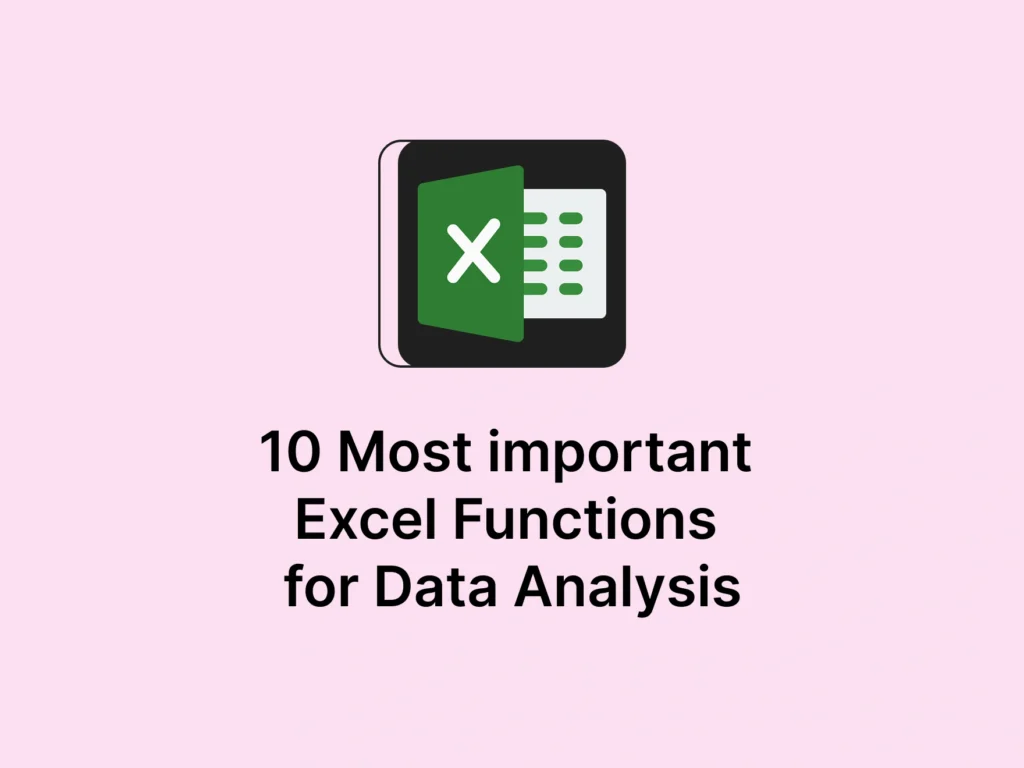Let’s say you’re interning at a marketing firm. Your manager gives you a big Excel file with 1,000 rows of customer data. She says, “Can you tell me how many customers we had last month, the average order value, and who spent the most?” Now, you could manually scroll through every row. Or you could use Excel functions and finish the task in 10 minutes.
Whether you’re analyzing sales, marks, or survey data — Excel is a skill every student or professional should learn. Let’s break down 10 Excel functions that are most useful for data analysis
1. IF Function
The IF function lets Excel make decisions. It checks whether a condition is true or false, and based on that, returns one value or another.
Why it’s important:
Helps in flagging values, filtering data, and handling logic-based conditions in spreadsheets.
Syntax:
=IF(logical_test, value_if_true, value_if_false)
Example:
Display “Pass” if a student scored above 50, else “Fail”.
=IF(B2>50, “Pass”, “Fail”)
2. SUMIFS Function
Adds values that meet one or more criteria.
Why it’s important:
Great for filtering and aggregating data, such as total sales in a region or product category.
Syntax:
=SUMIFS(sum_range, criteria_range1, criteria1, …)
Example:
Add sales (column C) where region (column B) is “North”.
=SUMIFS(C2:C10, B2:B10, “North”)
3. COUNTIFS Function
Counts how many times a set of conditions are met.
Why it’s important:
Useful to count filtered rows or patterns, like customers from a city who made purchases over ₹10,000.
Syntax:
=COUNTIFS(criteria_range1, criteria1, …)
Example:
Count entries where the region is “South” and sales are above 200.
=COUNTIFS(B2:B10, “South”, C2:C10, “>200”)
4. TRIM Function
Removes unwanted spaces from text, except single spaces between words.
Why it’s important:
Essential when cleaning up data imported from external systems (like PDFs or websites).
Syntax:
=TRIM(text)
Example:
Clean the text in B2 from extra spaces.
=TRIM(B2)
5. CONCATENATE (or CONCAT) Function
Joins values from multiple cells into one string.
Why it’s important:
Useful for combining names, creating unique identifiers, or forming text-based codes.
Syntax:
=CONCATENATE(text1, text2, …)
(Or use =CONCAT() in newer Excel versions.)
Example:
Join first and last names with a space.
=CONCATENATE(A2, ” “, B2)
6. LEFT / RIGHT Function
Extracts characters from the beginning (LEFT) or end (RIGHT) of a text.
Why it’s important:
Helps split codes, extract region initials, or parse ID numbers.
Syntax:
=LEFT(text, num_chars)
=RIGHT(text, num_chars)
Example:
Get first 2 letters from cell A2:
=LEFT(A2,2)
Get last 1 character from cell A2:
=RIGHT(A2,1)
7. VLOOKUP Function
Searches for a value in a column and returns data from a different column in the same row.
Why it’s important:
Useful for pulling related data from different sheets, like prices, product names, or IDs.
Syntax:
=VLOOKUP(lookup_value, table_array, col_index_num, [range_lookup])
Example:
Find the department of an employee.
=VLOOKUP(B2, G2:H10, 2, FALSE)
8. IFERROR Function
Returns a specified value if a formula results in an error.
Why it’s important:
Helps in cleaner reporting and better user experience when formulas may break (like VLOOKUP errors).
Syntax:
=IFERROR(value, value_if_error)
Example:
Use VLOOKUP and avoid ugly #N/A errors.
=IFERROR(VLOOKUP(B2, G2:H10, 2, FALSE), “Not found”)
9. VALUE Function
Converts text into numbers.
Why it’s important:
Critical when numbers are imported as text and Excel can’t perform calculations on them.
Syntax:
=VALUE(text)
Example:
Convert sales in B2 to number format.
=VALUE(B2)
10. PIVOT TABLES
Summarizes data without writing formulas.
How to use it
- Select your data range.
- Go to Insert > Pivot Table.
- Choose rows (e.g., Region), columns (e.g., Product), and values (e.g., Sales).
- Instantly see total sales by region/product.
Final Thoughts
Whether you’re a student just learning Excel or a professional trying to speed up your work — these 10 Excel functions will save you time and boost your data analysis skills. Excel may seem simple on the surface, but once you start using functions like VLOOKUP, IF, and FILTER, you’ll see how powerful it truly is.
At FACE Prep Campus, we offer hands-on training in data analysis, Excel, and Python — all guided by industry mentors and designed to help you land top roles.
FAQs
Q1: Are Excel functions still useful if I know Python or SQL?
Yes! Excel is often the first tool used for quick analysis or sharing results. Knowing Excel makes you more versatile.
Q2: Can I get a job with Excel skills alone?
For entry-level roles like data entry, reporting, or MIS, yes. But for data analysis, pair Excel with Python, Power BI, or SQL.
Q3: What should I learn after Excel?
Learn Power BI, SQL, or Python for Data Analysis to take your skills to the next level.
